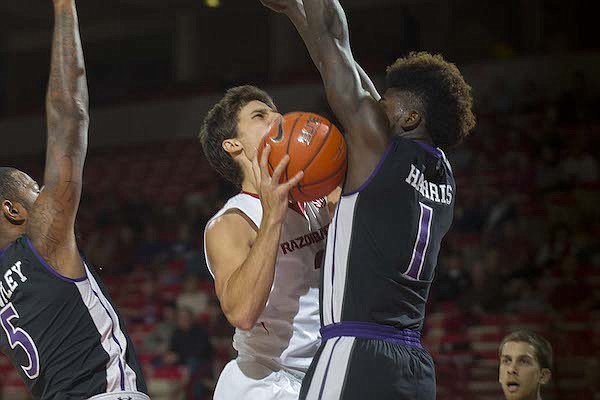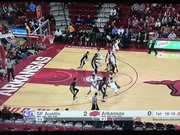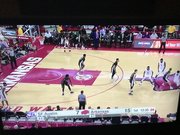FAYETTEVILLE — Five observations, with video, from Arkansas' 78-62 win over Stephen F. Austin.
— Hannahs taking what defenses give him
Dusty Hannahs failed to make a 3-pointer for the second straight game Thursday.
Last season, that occurred just four times in 32 games.Hannahs averaged 8.6 3-point attempts per 40 minutes last year, when 3s comprised 50.8 percent of his shots.
Opposing defenses have made running him off the line a priority this year, pressing up on him, closing out hard and being leery of digging off him to help. Arkansas’ unquestioned best shooter has shot less 3-pointers as a result, attempting 7.5 3-pointers per 40 minutes through six games this year, with 3s making up 40.6 percent of his field-goal attempts.
But Hannahs is leveraging defense’s fear of his shooting ability into driving lanes, attacking closeouts and getting into the lane for floaters or even all the way to the rim, where he’s shown a knack for finishing off-balance shots or getting fouled.
Anton Beard acted as a late-clock closer in Arkansas’ lone close game of the year, a 71-67 win over UT-Arlington, but Hannahs’ added juice off the bounce makes him an intriguing option to have the ball in his hands late in the game.
Moving forward, Arkansas needs to find better ways to free Hannahs for 3-pointers. Not only are his attempts down, he’s shooting only 32.1 percent. He’s a very good shooter and this is a small sample size. It’s almost certain he will snap out of this slump — he missed two very makeable shots Thursday. The Hogs need to get him more open looks.
Arkansas wriggled him free him for a lot of 3-pointers off pindown screens last year, actions it hasn’t run as much this season. Point guard Jabril Durham was also adept at getting the ball to Hannahs and Anthlon Bell at the right time in the right place, a knack new guards Jaylen Barford and Daryl Macon haven’t shown much yet.
After attempting just 14 3-pointers against SFA, Arkansas is only averaging 15.7 3s a game, shooting them at a rate that ranks 332nd out of 351 teams nationally and is lower than last year’s, which was easily the lowest of any team Mike Anderson has ever coached.
Hannahs alone can’t change that, but the he and the Hogs need to do a better job freeing him for looks. His increased verve for getting to the rim is encouraging, but the Razorbacks would no doubt prefer a world where he could do both — fire frequently from beyond the arc and get into the lane. So far they haven’t had a great answer for defenses’ determination to take the former away.
He's clearly more of a marked man this year. SFA guarded him with a box-and-one for stretches. More on that in a bit.
— Active defense bares teeth
Arkansas became the first team to double Stephen F. Austin’s bigs on a consistent basis Thursday night. The strategy was one of several shows of aggression by a disruptive Razorback defense that forced a season-high 21 SFA turnovers and turned them into 29 points.
Both teams struggled to get into a rhythm early, but Arkansas was the aggressor. The aforementioned double-teaming seemed to catch the Lumberjacks off guard.
When the Lumberjacks passed out of it, the Hogs generally did a good job nailing their rotations.
Arkansas also generated more turnovers off its press than in any other game this year, wreaking havoc in passing lanes when it actually turned up the heat.
Stephen F. Austin struggled mightily, scoring only 89.9 points per 100 possessions, a positive sign for an Arkansas defense that entered the night ranked 215th in the nation in defense, allowing 102.2 points per possession. That number dropped into the double digits as a result of Thursday’s game, with the Hogs KenPom adjusted defensive rating diving to a solid 97.5, 74th in the nation.
The Hogs’ man defense looked a lot better against SFA’s primarily motion offense than it had against the spread pick-and-roll teams that carved it up in earlier games. SFA sprinkled in some occasional ball-screen action, but it was far from a go-to action, keeping Arkansas from having to rotate as much. The result was some at-times stifling possessions against an outmatched team.
Everyone does a good job switching correctly. Daryl Macon has a heck of a possession, digging down to help before sprinting to recover with a closeout to the top of the key. He then pressures the SFA ballhandler into a shot-clock violation.
It would have been interesting to see the Hogs against yet another spread PNR team to continue to gauge how well (or poorly) the players rotated and communicated. But the Hogs were better on the defensive end than they had been.
— Halfcourt offense produces mixed results
Arkansas’ defense made life significantly easier for its offense, which was good news for the Hogs considering the curveballs SFA threw at them.
The Razorbacks were well-prepared for the Lumberjacks’ tendency to play high on the floor off the ball, camping in the passing lanes on the perimeter. This led to a number of buckets off backdoor cuts.
Anderson had the Hogs ready to attack the look throughout.
But SFA coach Kyle Keller switched it up and got funky, going to a box-and-one with a defender tracking Hannahs for stretches. It worked, gumming up Arkansas’ offense at times.
The Lumberjacks also went to a 2-3 zone later in the game, giving Arkansas different looks throughout in an effort to keep the Hogs off balance.
Arkansas began a number of possessions with set pieces, but often stagnated when SFA turned away the initial action. Someone may run off a screen or a big may flash to set a pick-and-roll, but the rest of the players regularly aren’t positioned in a way to either set up subsequent actions or maximize spacing.
In other instances, especially early, the Hogs simply stood around the perimeter, apparently freelancing, in possessions marred by a lack of movement and passing the ball around. The spacing in these scenarios is shoddy. In the photo to the left (click to enlarge), Hannahs, who would provide great spacing if parked behind the line, is unaware the pick-and-roll is even happening and cutting down the lane, essentially bringing another defender into the frame for Watkins.
Less-than-ideal spacing, which has been an issue early in the year.
The second photo is an example of typical spacing around a pick-and-roll, via the NBA’s Oklahoma City Thunder. Note how two players are parked in the corners, stretching the defense as thin as it can.
The spacing is great on the Arkansas double screen in the third photo. The Hogs must work to make that more the norm than the exception, to attack defenses with a purpose in the halfcourt.
Arkansas did excel by pushing the pace off turnovers and in semi-transition. Nice job here by Beard to not force it but attack before SFA can fully set its defense.
Arkansas’ defense has been its best source of offense early this year and was again Thursday, but the Razorbacks showed signs of being more aggressive and playing in attack-mode. That has to continue to be more of the norm rather than the tentative stretches when the game slows.
— Kingsley’s energy part of encouraging second half
Moses Kingsley’s first and second half mirrored the team as a whole. He had just two points and attempted just one shot in the first half.
He gets the ball on the block and draws the double, but decides to force a shot anyway, airmailing it over the rim.
He’s doubled again here, an SFA move harder to take advantage of with Manny Watkins throwing the entry pass and Arlando Cook perched at the foul line. Both of their defenders have no problem leaving them open for a look. May not be the same story if it was Hannahs entering the ball (to be fair, this was while SFA was employing the box-and-one). If nothing else, it would make the defense choose between two potentially good outcomes for the Hogs.
But Kingsley turned it around after halftime, scoring 10 points on four shots. He played with energy on both ends. He finishes with a hard-earned and-1 on a possession that he sparked by contesting an SFA shot on the other end and forcing an airball.
He ran the floor well, beating SFA’s big down the court and making himself available for a dish from Hannahs, which he converted for an and-1. And then there was this.
Late in the game, Arkansas ran a well-spaced spread pick-and-roll with Kingsley late, with a positive result.
Macon is downhill and causes emergency help from SFA, leaving Thomas open for a baseline jumper. Solid offense.
Kingsley was peppered with questions about his offense after the game and conveyed a good demeanor about his lessened offense. It will be interesting to see how Anderson and Co. continue to problem solve the way defenses are keying on Kingsley and Hannahs, both in trying to free them for shots and use defenses’ focus against them.
— Manny Watkins draws rave reviews
Keller went out of his way to point out the difference a role player like Watkins makes postgame without being prompted, noting a lot of what he does goes unnoticed and isn’t likely talked or written about (for the record: Watkins receives regular platitudes in this space, including after Tuesday’s game).
Watkins finished with eight points, seven rebounds, two steals and an assist Thursday, a +17 in 21 minutes on the court. AP writer Kurt Voigt made the astute observation that Arkansas loves its floaters, between Watkins, Hannahs and Anton Beard. It’s Watkins go-to shot, one he’s essentially mastered. He’s shooting 57 percent this year and if the buckets aren’t layups, they’re almost assuredly floaters.
Great herky jerky hesitation to find some airspace to get the floater off.
But scoring is near the bottom of the list of ways Watkins impacts the game. He can play the role of distributor and primary ballhandler, setting teammates up. He’s averaging 2.2 assists, third on the team.
And he is the most heady, sturdy perimeter defender on the roster. He’s an instinctive player who makes plays on that end of the court and also covers up for mistakes that his teammates make.
His seven rebounds were a team-high and he’s averaging a career-best 4.3. It would have been ideal if he’d have redshirted as a freshman rather than log 27 minutes, but he is a great complimentary piece who is playing some of his best basketball as a senior.
Stray Thoughts
— C.J. Jones led all scorers with six points at halftime after knocking down both his 3-point attempts. Keller mentioned his offensive ability postgame.
— Keller spoke glowingly about Arkansas in general after the game. Even called Hannahs an underrated defender. So, yeah.
— Kingsley went without a block for the first time this year. His average is ‘down’ to 3.3 per game.
— Arlando Cook made a heady rotation defending a pick-and-roll in the first half, switching and sliding from his man at the top of the key to take the roll man while Trey Thompson trapped. Thompson recovered to Cook’s man and SFA’s action was stonewalled. The Knicks actually experimented with a version of this a few years ago on the team that made the playoffs.
— Adrio Bailey was the first big off the bench in the second half and played the most minutes (12) of the bench bigs for the first time this year. He’s still raw and wasn’t spectacular, finishing with two points, a turnover and four fouls in 12 minutes. He was a -4 and his rebounding and shotblocking has yet to really translate to this level, but the extended run was a nice November/December move by Anderson.
— Lot of sloppy, unforced turnovers. Hogs only finished with 13, but there were some bad ones.




